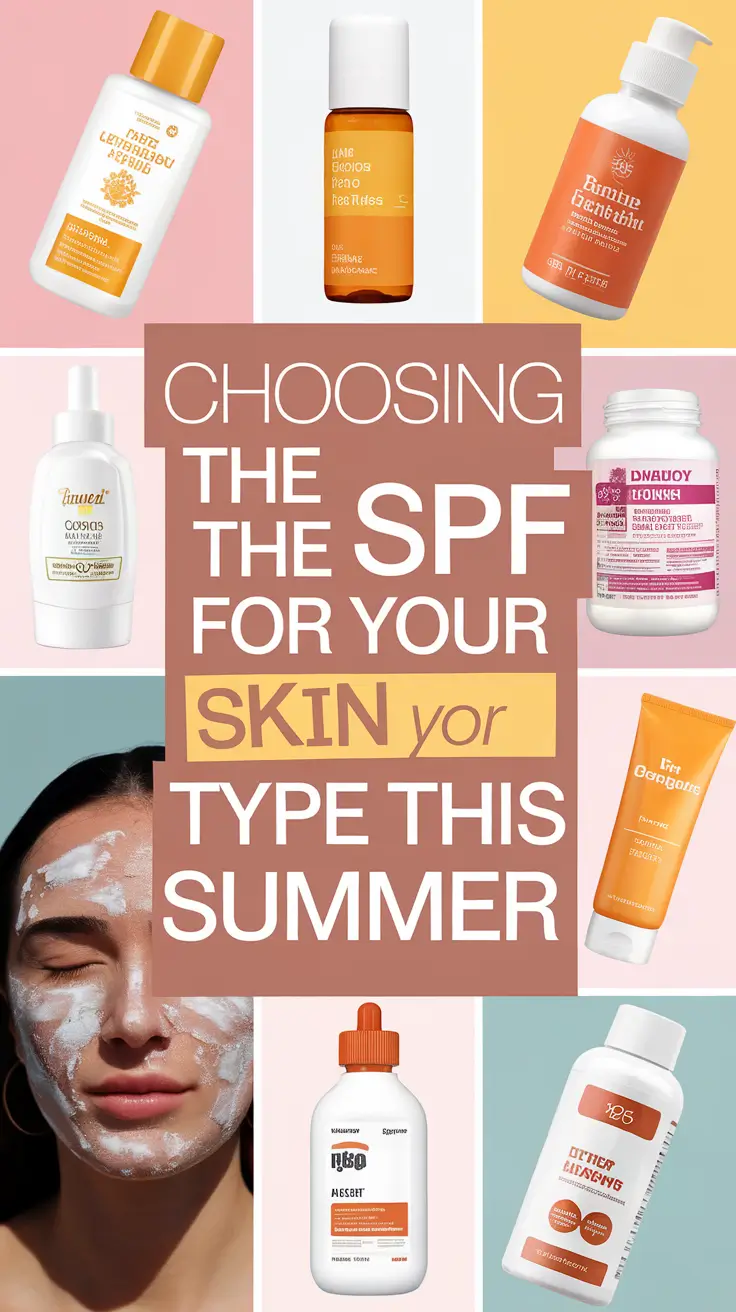How to Choose the Best SPF for Your Skin Type in Summer 2025 — My Personal Guide
Have you ever stared at a shelf full of different sunscreens and felt utterly confused? Well, that was most definitely me last summer. I remember standing in the store, holding two almost identical bottles, wondering what the difference between “extra hydration” and “matte finish” was. All I wanted was something that protected my skin without making me look like a glazed donut.
I know finding the right SPF can feel like a puzzle that needs to be solved, especially when people around you swear by using different products. Is it oily skin? Dry skin? Combination skin? And we haven’t even touched on mineral vs chemical formulas.
If you have ever felt overwhelmed, or even worse, ended up sunburned after layering on SPF, I’m glad you’re here. In this guide, I’m going to share what worked for me, how to determine your skin type, and knowing what SPF formulations are best to keep your skin protected and happy this summer.

Reasons Why SPF should Top Your To-Do List This Summer
For better or worse, we’ve all come across the phrase, wear sunscreen, at least once in our lives. Avoiding SPF was never an issue for me until I had one too many playlists to sing along to during a day at the beach. By the end of the week, I’d had my own personal version of hell consisting of redness, peeling, and a myriad of sunburn relief treatments under my eyes.
The reality of the situation is that suns rays are merciless. Whether it’s sunny, cloudy, or somewhere in between, those rays are unrelenting. Aside from inflicting a painful burn, UV rays are known for being one of the major contributires to accelerated skin aging, burning, sunspots as well as skin cancer.
Sun Damage Facts Everyone Should Know
- Sun related skin damage is known to cause up to 90% of visible skin aging.
- UVA (aging) and UVB (burning) rays have the ability to pass through glass and clouds.
- Wearing sunscreen consistently can lower the chances of contracting skin cancer by 30%.
So yes, sunscreen is not limited for use on beach days or vacations. It should be considered a daily essential regardless of any plans.
Determine Your Skin Type: The Initial Step to Picking The Correct SPF
It’s vital understanding your skin type before picking a sunscreen. I used to think all SPF was the same, but differently formulated SPF products have had a noticeable impact on how my skin looked and felt differently.
3 Steps To Determine Your Skin Type:
- Morning Routine: Splash water on your face, but do not apply any products. Assess your skin by midday:
- Greasy and Shiny? You have oily skin.
- Dry and Flaky? Dry Skin.
- A bit of both? Combination Skin.
- Product Reaction: Burning or redness after applying moisturizers or serums suggests skin sensitivity.
- Pore Size: Enlarged and visible pores point towards oily skin, while small or barely visible pores are an indicator of dry skin.
Finding the right SPF becomes comfortable and effective once you’ve figured out your skin type.
How to Select the Right SPF for Each Skin Type
Now that you know what your skin type is, lets narrow it down even more. The wrong SPF could lead to oily skin breaking out, dry skin feeling tight, or even inflamed skin for sensitive skin. After far too much trial and error, here’s what worked for me.
Oily and Acne-Prone Skin
For a long time, I did not use sunscreen because all formulas made my face greasy. Turns out, there is such a thing as lightweight, oil-free SPFs — and they’re a game changer.
What to Look For:
-
- Oil-free, gel-based products
- Niacinamide (oil reduction) and zinc oxide (skin calming)
- Non-comedogenic labels
My Favorite Picks:
-
- Neutrogena Clear Face Liquid-Lotion Sunscreen SPF 55 (doesn’t clog pores)
- La Roche-Posay Anthelios Clear Skin Oil-Free SPF 60 (non greasy and matte look)
Dry and Sensitive Skin
One summer, I remember switching to a mineral sunscreen and my face felt like sandpaper. This taught me a valuable lesson: dry skin needs moisture, not the lack of it.

What to Search for:
-
- Refreshing, hydrating cream types
- Ingredients of ceramides and hyaluronic acid
- No fragrance to avoid unwanted inflammation
My Most Cherished Selections:
-
- CeraVe Hydrating Mineral Sunscreen SPF 30 (very calming)
- Aveeno Positively Mineral Sensitive Skin Sunscreen SPF 50 (sooth and gentle)
Combination Skin
Cheeks feeling dry while the T zone is shiny gives a sense of nullified efforts. I have found out that layering works.
What to Search for:
-
- Light and thin coverage for the oily regions
- Moisturizing factors for dry areas
My Most Cherished Selections:
-
- EltaMD UV Clear Broad-Spectrum SPF 46 (thin and moisturizing)
- Neutrogena Hydro Boost Water Gel Lotion SPF 50 (quick absorption)
Physical vs. Chemical Sunscreens — Which One Is Right for You?
These two types of formulas–alike in purpose but so different in application–were eye opening for me when I first started exploring UV-blocking cosmetics.
| Feature | Physical SPF | Chemical SPF |
|---|---|---|
| Ingredients | Zinc Oxide, Titanium Dioxide | Oxybenzone, Avobenzone |
| Texture | Thick, white cast | Lightweight, no cast |
| Best for | Sensitive, acne-prone skin | Normal to oily skin |
| Protection | Immediate | Requires 20-minute wait |
Women with sensitive or acne outbreaks tend to appreciate physical SPFs more gentle SPF. Those with oily or combination skin typically prefer chemical formulas as they are less heavy.
Mistakes with SPF Application That Should be Avoided This Summer
One of the mistakes I used to make was applying SPF after my moisturizer. That made it less effective. Here are a few more that should be avoided:
- Skipping Reapplication: Must be done every two hours especially while sweating or swimming.
- Using Too Little: For the face and neck, aim for a teaspoon.
- Forgetting Key Spots: Ears, neck, and tops of feet should not be neglected.
3 Steps to Make SPF a Daily Habit
- Placement: Keeping it next to toothpaste guarantees no excuses to forget.
- Find One You Love: Use ensures more frequent application.
- Make It Part of Your Routine: Apply after moisturizer and before makeup.
Conclusion
A little trial and error is required in finding the right SPF for your skin, but nothing beats enjoying the summer sun without worrying about potential damage.
Don’t forget to pin this guide for later, and do tell me what your go-to SPF is this summer?

